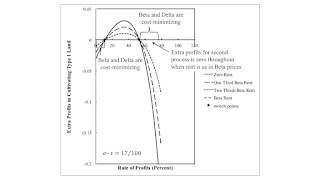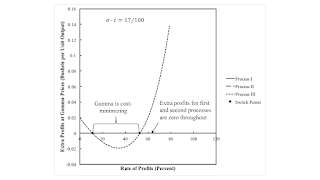Figure 1: Extra Profits with Given Rent On Type 2 Land1.0 Introduction This post revisits this example of extensive rent. I repeat quite a lot from that post. Prices of production are defined, in models of circulating capital alone, from a given technology, requirements for use, and either the wage or the rate of profits. I usually take requirements for use as given by net output and assume constant returns to scale. Since I am concerned with a choice of technique, I am not disagreeing with Sraffa in assuming constant returns. These givens also determine prices of production in models of pure fixed capital. The example shows that these givens are insufficient to determine prices of production in special cases in the theory of extensive rent. The givens can be compatible with a
Topics:
Robert Vienneau considers the following as important: Example in Mathematical Economics, Joint Production, Sraffa Effects
This could be interesting, too:
Robert Vienneau writes Austrian Capital Theory And Triple-Switching In The Corn-Tractor Model
Robert Vienneau writes Double Fluke Cases For Triple-Switching In The Corn-Tractor Model
Robert Vienneau writes The Emergence of Triple Switching and the Rarity of Reswitching Explained
Robert Vienneau writes Recap For A Triple -Switching Example
| Figure 1: Extra Profits with Given Rent On Type 2 Land |
This post revisits this example of extensive rent. I repeat quite a lot from that post.
Prices of production are defined, in models of circulating capital alone, from a given technology, requirements for use, and either the wage or the rate of profits. I usually take requirements for use as given by net output and assume constant returns to scale. Since I am concerned with a choice of technique, I am not disagreeing with Sraffa in assuming constant returns. These givens also determine prices of production in models of pure fixed capital.
The example shows that these givens are insufficient to determine prices of production in special cases in the theory of extensive rent. The givens can be compatible with a continuous range for prices of production. As I understand it, this indeterminacy, however, only arises in the parameter space for models of extensive rent for a set of Lebesque measure zero. In this sense, the properties of the circulating capital model emphasized above extend to models of extensive rent. Some properties do not. In particular, prices of production can vary with sufficiently large variations in requirements for use. Nevertheless, I think fixed capital and extensive rent (both together?) are compatible with the Sraffian reconstruction of the theory of value and distribution in classical political economy.
Problems arise, though, with models of intensive rent and general joint production. The sort of indeterminancy illustrated in this post can exist in those models in a set in their parameter space with a positive Lebesque measure.
2.0 Technology and Requirements for UseConsider a capitalist economy in which two commodities, iron and corn, are produced. One process is known for producing iron. In the iron industry, workers use inputs of iron and corn to produce an output of iron. The output of the iron industry is one ton with the inputs shown in Table 1. Two processes are known for producing corn. Each corn-producing process operates on a specific type of land. The coefficients of production shown in Table 1 are for an output of one bushel corn. These processes can be thought of as examples of joint production. Their outputs are corn and the same quantity of land used as input, unchanged by the production process. Presumably, some of the labor in these processes is used to maintain the land in a given state. For this post, I assume σt is 17/100.
| Input | Iron Industry | Corn Industry | |
| I | II | III | |
| Labor | a0,1 = 1 | a0,2 = 5191/5770 | a0,3 = (305/494) e(3/20) - σt |
| Type 1 Land | 0 | c1,2 = 1 | 0 |
| Type 2 Land | 0 | 0 | c2,3 = e(3/20) - σt |
| Iron | a1,1 = 9/20 | a1,2 = 1/40 | a1,3 = (3/1976) e(3/20) - σt |
| Corn | a2,1 = 2 | a2,2 = 1/10 | a2,3 = (229/494) e(3/20) - σt |
The specification of technology is completed by noting the values of parameters for the quantities available of non-produced means of production. For this numerical example, let there be 100 acres of type 1 land and 100 acres of type 2 land. The iron-producing process and each corn-producing process exhibits constant returns to scale, up to the limits imposed by the endowments of land.
I consider stationary states with a net output consisting solely of corn. A bushel corn is the numeraire. Any one of four techniques can be used to produce corn, depending on the requirements for use. The process for producing iron is part of each technique. Table 2 specifies which types of land are fully or partially farmed in each technique. In the Alpha and Beta techniques, both types of land are cultivated, with one type only partially farmed. In the remaining two techniques, one type of land is left totally farrow. Which techniques are feasible depends on the endowments of the land and on the requirements for use.
| Technique | Type of Land | |
| Type 1 | Type 2 | |
| Alpha | Fully farmed | Partially farmed |
| Beta | Partially farmed | Fully farmed |
| Gamma | Partially farmed | Farrow |
| Delta | Farrow | Partially farmed |
I pick a point in logical time, where σ t is 17/100, to fix the technology. Suppose requirements for use are such that they can be satisfied by totally cultivating type 2 land and leaving type 1 land farrow. That is, net output is approximately 55.112 bushels. The common limiting case of the Beta and Delta techniques is feasible.
3.0 Prices of ProductionUnder the assumptions, requirements for use can also be satisfied by partially cultivating type 1 land, and leaving type 2 land farrow. When the Gamma technique is adopted, neither type of land is scarce and their rents are zero. Prices of production, for a given rate of profits, for the Gamma technique, solve the following system of equations:
(p a1,1 + a2,1)(1 + r) + w a0,1 = p
(p a1,2 + a2,2)(1 + r) + w a0,2 = 1
One can find the difference between the revenues and the costs for each process, where the value of capital goods are found at the going rate of profits. For example, extra profits for the third process operated at a unit level at Gamma prices, sγ,3(r), are specified as follows:
sγ,3(r) = 1 - ((pγ(r) a1,3 + a2,3)(1 + r) + wγ(r) a0,3)
The notation emphasizes that the price of iron and the wage are functions of the rate of profits. Since under Gamma rents are zero, no coefficient of production for land appears in the above equation. Figure 2 displays extra profits for each process at a unit level. One can see that the Gamma technique is cost-minimizing only at an intermediate range of profits.
| Figure 2: Extra Profits with Gamma Prices |
Return to the case in which type 1 land is farrow and all type 2 land is farmed, the limiting case for both the Beta and Delta techniques. Suppose the rent on type 2 land, ρ2, is given. It is between zero and the bound from the Beta technique, inclusive. For the Beta technique, rent and prices of production, as functions of the rate of profits, are found by solving the system of equations specified by the first two equations above and the following equation:
(p a1,3 + a2,3)(1 + r) + ρ2c2,3 + w a0,3 = 1
For rent on type 2 land in the interior of this range, prices of production are found, given rent and the rate of profits, by solving the system of two equations given by the first and last equations above.
From these prices of production, one can find extra profits obtained in operating each of the three processes specified in the technology. Extra profits are zero in operating the first and third process. Figure 1 graphs extra profits, sδ,2(r, ρ2), against the rate of profits for four levels of the rent per acre for type 2 land, in operating the second process to produce a bushel corn. The rent per acre for type 2 land is zero or negative between the switch points. Outside the switch points, rent per acre for type 2 land ranges between zero and a positive upper bound. The technique associated with this continuum for prices of production is cost-minimizing in these ranges outside the switch points.
4.0 ConclusionAny lower requirements for use can be satisfied by cultivating type 2 land alone, with some of type 2 land remaining farrow. The rent on type 2 land is then zero. Given the rate of profits, the system of linear equations for the Delta technique have a unique solution for the wage and the price of iron. Any higher requirements for use necessitate the cultivation of at least some type 1 land. A system of three linear equations can be solved, given the rate of profits, for the wage, the rent on type 2 land, and the price of iron. In either case, prices of production are determinate.
I call this fluke case a pattern for requirements for use. I think I have not previously noted this indeterminancy in models of extensive rent.
 Heterodox
Heterodox


